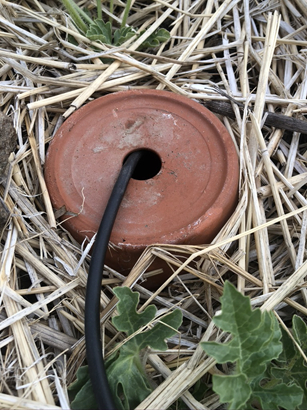
| Home | Source Reduction | Friends of Green Friends | Newsletters |
| Gardening | Resources | What You Can Do | Embracing The Trees |
| Water is Sacred |
 A section of the orchard in early spring |
|
Amme Saranam
Conservation of Water is our Sacred Duty As stewards of Nature, as gardeners and arborists, much of our activity is necessarily centered around water. Amma is always reminding us that each drop of water is precious; not a single drop is to be wasted. So it is important to bring that awareness to all that we do when planning and caring for Amma’s orchard and garden projects. Water is sacred. It is the bringer and sustainer of life, and in the end perhaps, water will become one of the final arbiters of human survival. A central belief of traditional Native American culture is that water is sentient. Water is sacred. Water is life. In the ancient Vedas of India, one of the first references is to water: "salilam apraketam", which describes our world as "originally water, without light’" (Rig Veda X.29.3). Traditionally, the first prayer and offering of the day, aachaman, involves the ritual of sipping water for purification when commencing the worship. Enough background, Much of this is already known, so let us take a moment to consider, "Why write about water?" This past rainy season in Northern California, where Amma’s MA Center San Ramon GreenFriends Farm is located, was the third-driest year since record keeping began in 1887, and this past month, it has been reported that the reservoirs in our NorCal bioregion are only half full. Even before this dire announcement, the teams that manage the GreenFriends Farm horticultural activities had begun researching and implementing water conservation methods. Many may already know about various ways to save water, but we would like to share a few of the best practices we have selected and put in place. |
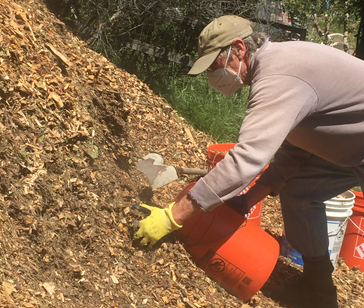 Anand gathering mulch |
|
Mulching The first and foremost water conservation method we have implemented is mulching. Research shows that proper mulching can reduce water use by 25%. Most of us are familiar with using mulch to minimize evaporation, but it has many other benefits as well. Keeping the soil temperature cooler in the 125-degree heat waves in summer and warmer in the cool winters, mulch also suppresses weed growth, prevents erosion, enhances the fertility and quality of the soil over time, and promotes healthy microorganisms that help trees and gardens thrive. There are many types of mulch that we use, such as composted manure, straw, composted leaves, and select wood chips free of disease, as well as black walnut or eucalyptus. Placed around fruit trees, but not up against the tree trunk, at least 2 inches thick, mulch can literally save tons of water annually. |
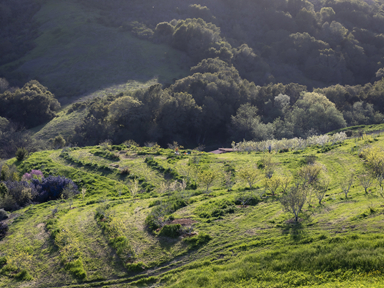 Contour planting |
|
Contour Planting All of the orchard is on sloping land. As much as possible since the orchard expansion began in 2008, we have been planting the trees along the contour lines. Planting this way helps slow the runoff of winter rains, which reduces soil erosion and enables the most rainwater to percolate more deeply into the soil. |
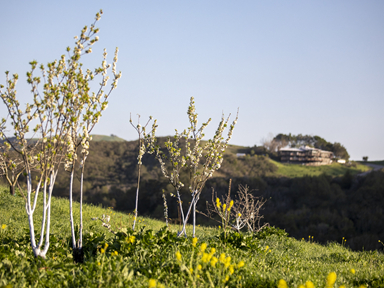 Mustard green manure in the orchard |
||
| Cover Cropping, a.k.a. Green Manure
Cover crops may also be familiar to you, but just to refresh, nitrogen rich, quick-growth cover crops such as mustard, red clover, winter rye, vetch, flax, amaranth, legumes and/or buckwheat are sown between the rows of fruit trees. In San Ramon, we are using primarily mustard and red clover, which are very drought tolerant, to hold moisture in the surrounding soil, to keep the soil temperature cooler with their canopy, and to suppress unwanted weeds that consume precious water, all of which in turn helps conserve water. Before the cover crop goes to seed, it can be mowed to act as a "green mulch" around the fruit trees, or tilled back into the soil to compost, directly nourishing the soil’s fertility. Cover crop seed can be expensive, but it is possible to let the crop go to seed and become perennial. Selection of which cover crop to plant also depends on what climate and soil you have, so be sure to research the recommendation for your area. |
||
|
Ollas
|
||
|
Deep Stake Water Delivery System This is the latest water conservation development being introduced in Amma’s GreenFriends Farm orchards, and it is as modern as the ollas are ancient. Perforated pipes that are 24” to 36” long are drilled into the ground around the canopy line of the tree. Water is introduced into the piping via ‘spaghetti line’ drip irrigation and delivered directly to the root zone of the fruit trees. We are excited and hopeful to see the impact on water conservation during this year of extreme drought in California, but our preliminary calculations estimate that instead of 4 gallons of water needed in the past to saturate to the root depth, only 1¼ gallon will be needed due to the efficiency of the deep stakes’ ability to deliver water directly to the root zone. This will have the added benefit of depriving surface weeds from taking the water away from the fruit trees that depend on water during the fruit-bearing cycle. This means that we can save 40% of water and that is our goal. Because water is precious and scarce, conservation has become the mantra of our effort in Amma’s orchards and gardens. To grow fruits and vegetables at the GreenFriends Farm with awareness of how our efforts can beneficially impact the broader ecosystem, we support the bees, the wildlife, the ponds, and the wellness of the water cycle in the long term. By Amma’s grace and our effort, may the abundant beauty of Nature be found within and around us at the same time. May the rains around the world be gentle and abundant, falling at the correct time and season so that all of Creation is nourished and harmonious. That is our prayer. By Amma’s grace, all this is possible! Kusuma-ji, for the core GreenFriends Farm orchard team including Muneebah and Jay - San Ramon, CA |
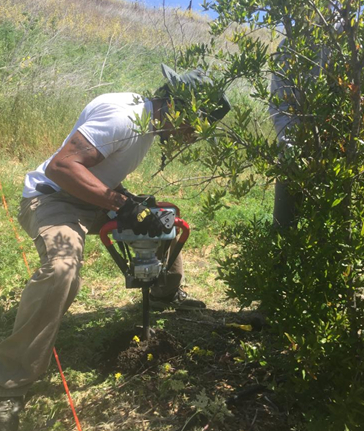 Drilling first before inserting the stakes |
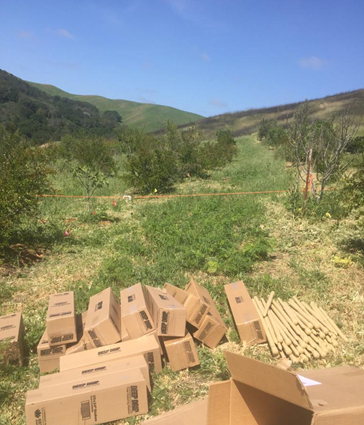 Irrigation stakes ready to install |
Read about Saukhyam Resuable Pads from the Q2 2021 newsletter >>
| Home | Source Reduction | Friends of Green Friends | Newsletters | Resources | What You Can Do | Contact Us |
For more information, e-mail info@greenfriendsna.org |
||||||
